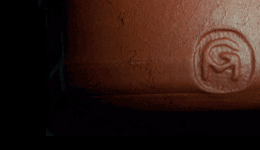This is a request for suggestions to deal with a problem I have with white earthenware clay and my glaze. For over twenty years now I have been making my work with D’Arcy’s Redart earthenware clay which has added micah, from Clay Art Center, Tacoma. I apply my coloured slips and in small areas some red or orange underglazes, and when bone dry, I paint terra sigillata on some areas and bisque to cone 06. I glaze with Deb’s Clear, a good-looking but tricky-to-get-just-right, non-lead clear 04 glaze that I mix up myself.
Deb’s Clear recipe Frit 3134 30, Frit 3195 45, EPKaolin 25, Zinc oxide 1
Eric began by having me make him tea sets, a dinner set and later a whole group of Classical Greek vessels, all with the red clay. But later he and then some of the other artists who join us (dubbed the Raiders, because they raid McMillans to paint and eat!) asked for white clay forms to paint. I chose the same white earthenware clay which Port Moody Arts Centre has used for years, mainly for children’s classes – Plainsman F100, and glaze the work with my Deb’s Clear. We’ve developed an easy system of my providing a large selection of underglazes which the artists apply to bone dry plate forms.
Bisque and glaze-firing all their work alongside mine, using the same glaze, has made my life simple but over the last year there have been some alarming occasions of ‘shivering’. Never in all the years of my use of red clay and Deb’s Clear have I had this happen, but on the edges of some of my guests’ plates there appear nasty rough areas where the glaze pops off. It just peels away, just on sharp edges.
We’ve considered all sorts of causes – underglaze applied too thick there, perhaps not really ‘marrying’ because of oil on the painter’s hands, too much handling when painting – re-firing, which I have done very occasionally. One platter recently had this happen and I’ve told the artist that we need to photograph the piece and then destroy it. It can’t be used, except perhaps sealed on the edges with some product, and hung on a wall.
So my question to anybody who has experience with this is, what should I do? I’ve tested Duncan cone 04 clear alongside my glaze and they seem identical. Does anyone have a glaze they recommend and I’ll buy a large bucket of it for dipping as usual – I don’t plan to start painting glaze, much too time-consuming and not sufficiently even. If you have a totally reliable glaze recipe for me to test and mix that would be super. Or would you recommend my using a better smooth white clay (hopefully available in the Pacific North-West). Tony Hansen, if you read this, can you help me?
Meanwhile I have another seven plates to glaze tomorrow, and I’ll proceed as usual, making sure not to apply the glaze too thick, and soaking for 30 minutes at the end for a super smooth surface. But I’ll be anxious that the problem could happen again and I don’t want to welcome artists here if I can’t guarantee the quality of their work. Please post any comments, suggestions or recipes below or email me at gillianmcmillan@shaw.ca
Thank you

Pingback: Clay Blog Review: February 2017 - Pottery Making Info